- Top Page
- Services
- Marine Consulting
- Assessment of Safety of Ship in Berth
Marine Consulting Assessment of Safety of Ship in Berth
- Proposing safety measures for moored ship
- Analyzing of side-by-side mooring of vessels (ship-to-ship transfer operation)
- Researching the effects of tsunami on moored ships
- Proposing means to reducing moored ship motion caused by long-period waves
Proposing safety measures for moored ship
We propose effective and safety measures predicting limitations on cargo handling operations and mooring limits by estimating the calmness of port/harbor areas based on meteorological/oceanographic status and simulating moored ship motion induced by wave and wind conditions.
- Harbor tranquility analysis using Boussinesq Model
- Numerical simulation of moored ship motion (induced by waves)
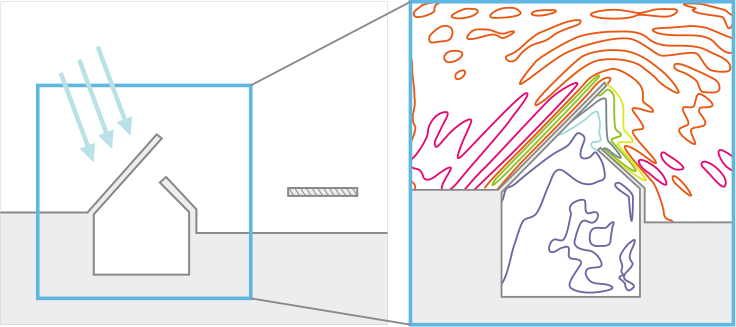
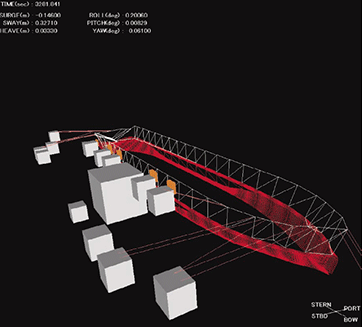
Analyzing of side-by-side mooring of vessels (ship-to-ship transfer operation)
Ship-to-ship (STS) cargo transfer operation by oil and LNG tankers in harbors and offshore has been increasing in recent years. Our advanced simulation technology enables us to numerically evaluate the safety of vessels moored side by side, taking into account ship motions caused by wind and waves.
The system calculates hydrodynamic forces considering the interactions between the two vessels, and output data for time domain analysis comprises ship motion, mooring line tension, and reaction/deflection forces of fenders installed on the jetty and positioned between the two vessels.

Researching the effects of tsunami on moored ships
Using the following simulation methods, MOL Marine & Engineering studies emergency unberthing methods, and ways to safely anchor and moor in sheltered water, based on water level fluctuation and speed data gained from tsunami simulations. This research helps us provide our clients with appropriate criteria for tsunami evacuations and help them develop effective emergency response manuals.
- Numerical simulation of tsunami effects
- Ship handling simulation for emergency unberthing
- Shiphandling simulation for anchoring
- Shiphandling simulation for mooring in sheltered water
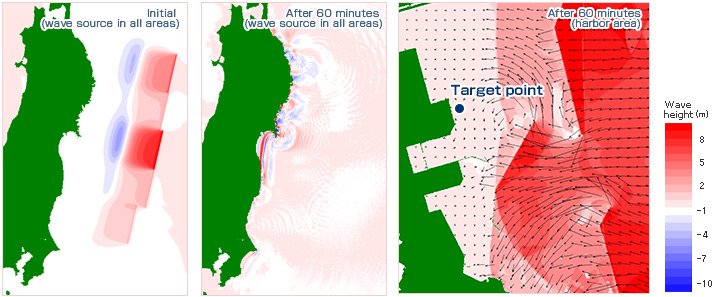
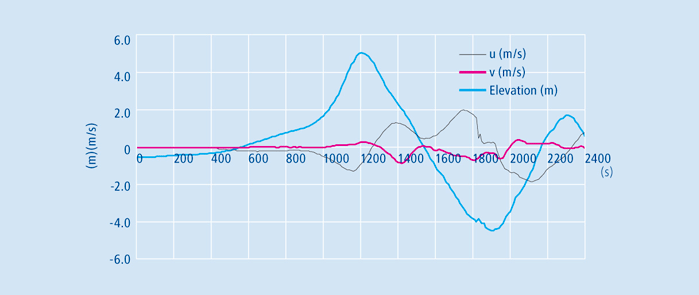
Investigation flow for preparation of emergency response manual
- Investigation conditions
-
- Earthquake (fault break parameters)
- Harbor
· Harbor design
· Water depth(inside / outside harbor) - Ships and mooring facilities
· Ships, mooring arrangements, etc.
· Mooring equipment
- Investigation methodology
-
- Tsunami numerical simulation
→ Evaluation of earthquake and tsunami hitting harbor - Shiphandling simulation for emergency unberthing
→ Evaluating ship handling method for emergency unberthing and safety - Anchoring simulation
→ Evaluating slewing motion of the hull and safety of anchoring - Shiphanding simulation for mooring in sheltered water
→ Evaluation of effects of earthquake and tsunami on moored ships
- Tsunami numerical simulation
- Preparation of Emergency Response Manual
-
- Evaluating criteria for evacuation
Preparation of criteria for evacuation based on forecasts of tsunami wave height and arrival time - Manual for emergency unberthing
Preparation of a manual for emergency unberthing operation - Manual for mooring in sheltered water
Preparation of a manual for mooring a ship in sheltered water
- Evaluating criteria for evacuation
Proposing means to reducing moored ship motion caused by long-period waves
We evaluate and investigate the effects of long-period waves on moored ships based on the results of ship motion simulations and field measurements of motion of actual ships, and propose an appropriate method to reduce motion.
- Numerical simulation on moored ship motion induced by long-period waves
- Measurement of moored ship motion
- Proposed means of reducing moored ship motion
Use of shore winche
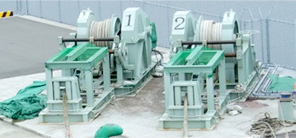
Locations for installation of shore winches must be determined in accordance with the mooring method used with the ships, and the manner in which the berth is used. Furthermore, selection of super-fiber shore mooring lines allows an increase in the mooring forces.
Simulations of ship motion and demonstration experiments have confirmed that the use of hard mooring lines (super-fiber lines) fitted to shore winches reduces ship motion compared to the case in which such mooring lines are not used.
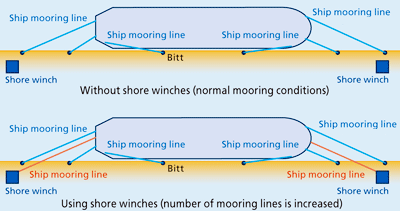
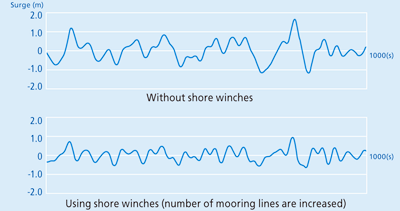
- Demonstration experiments with a long-period motion reduction system
-
The Japanese Ministry of Land, Infrastructure, Transport and Tourism installed the long-period motion reduction system, which was developed by Port and Airport Research Institute (PARI), in Hibarino-cho area of the Ishinomaki Port and in Sanri area of the new Port of Kochi, to verify effects of reducing motion of moored vessels.
In the experiment in the Ishinomaki Port, the reduction motion effects in was investigated by varying the ratio of shore mooring lines when two head lines and two stern lines were connected with shore mooring lines and by increasing the number of shore mooring lines connected directly to the bollards on the ships. As shown by the relationship between long-period wave height and surging in the diagram, we found that increasing the number of shore mooring lines directly connected to the ships clearly had the greatest effect in reducing surging.
We propose a practical method of reducing ship motion caused by long-period waves based on our know-how and experience accumulated through demonstration experiments with this system.
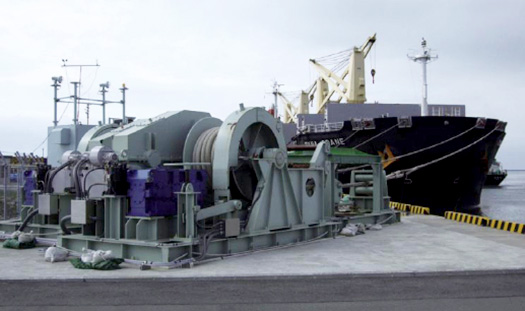
Installation of Shore Winches 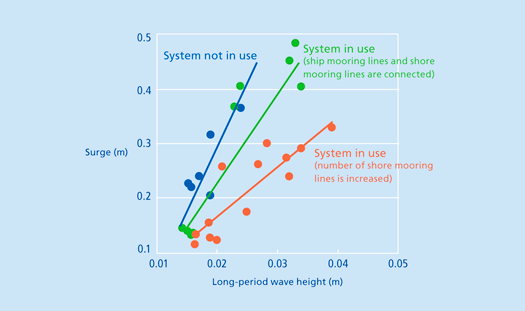
Reduction Effects in ship motion Obtained by Experiment
